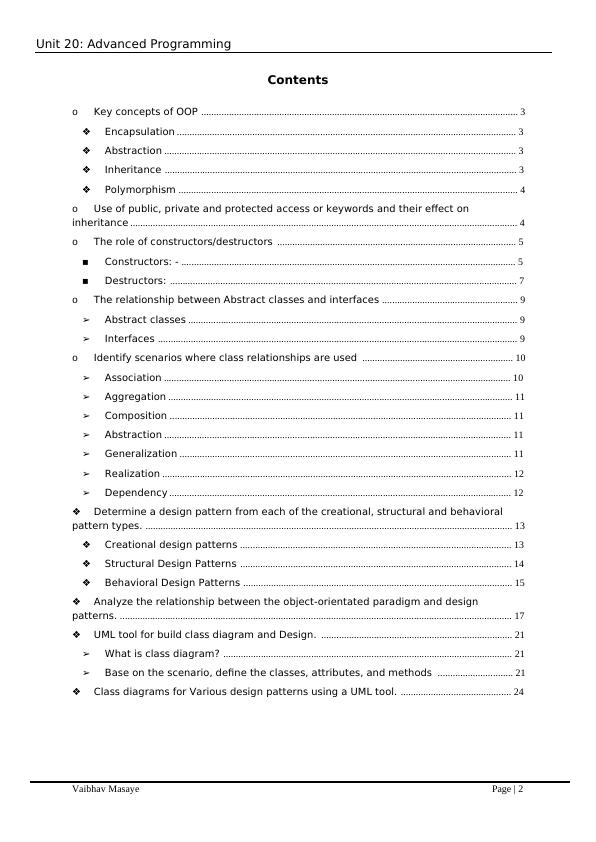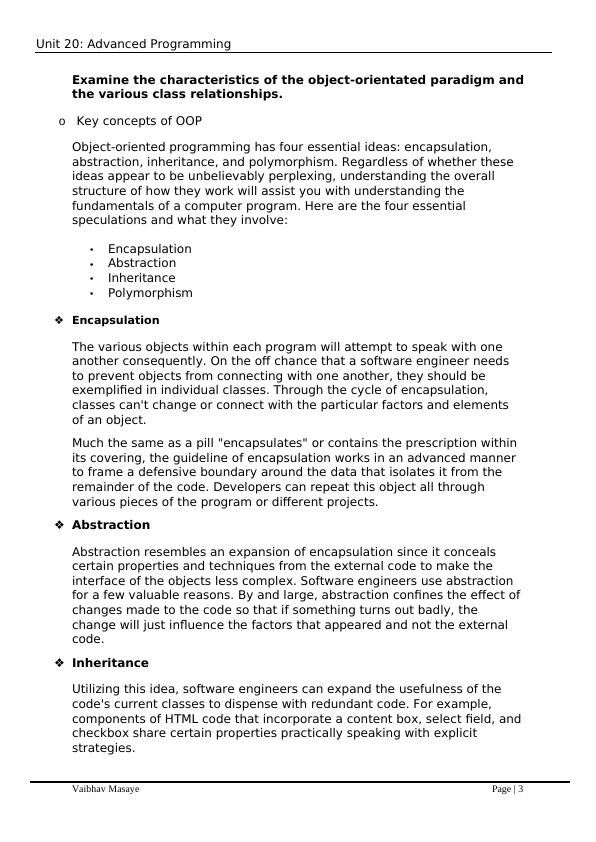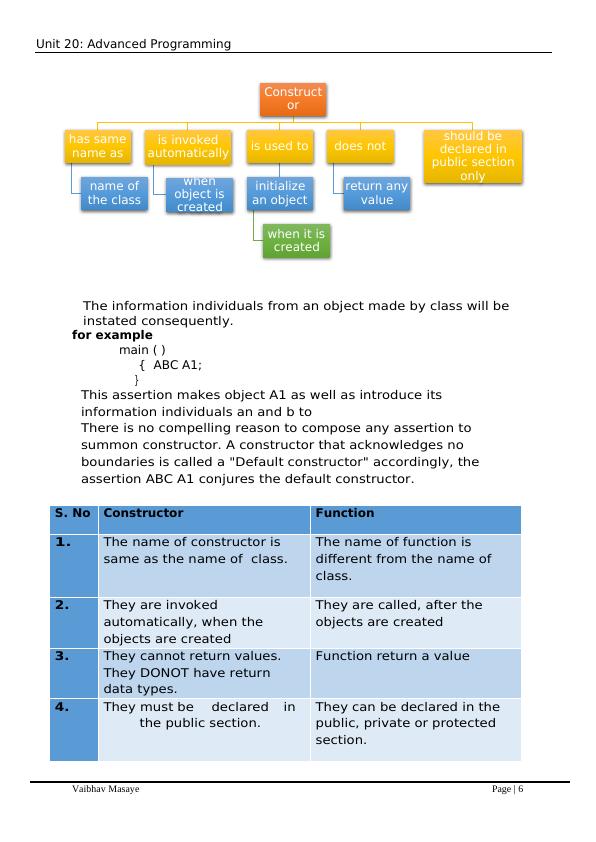Assignment on Application Development
Added on 2021-05-07
28 Pages9269 Words140 Views
Pearson Education 2018 Higher Education Qualifications STUDENT ASSESSMENT SUBMISSION AND DECLARATION When submitting evidence for assessment, each student must sign a declaration confirming that the work is their own. Student name: Vaibhav Masaye Assessor name: Neha JaiswarIssue date: 14 Oct0ber 2020 Submission date: 31 December 2020Submitted on: 31 December 2020 Programmer: Pearson BTEC Level 5 HND in Computing (Application Development) Unit 20: Advanced Programming Assignment number and title: 1 of 2: Advanced Programming – Part 1 Plagiarism Plagiarism is a particular form of cheating. Plagiarism must be avoided at all costs and students who break the rules, however innocently, may be penalized. It is your responsibility to ensure that you understand correct referencing practices. As a university level student, you are expected to use appropriate references throughout and keep carefully detailed notes of all your sources of materials for material you have used in your work, including any material downloaded from the Internet. Please consult the relevant unit lecturer or your course tutor if you need any further advice. Student Declaration Student declaration I certify that the assignment submission is entirely my own work and I fully understand the consequences of plagiarism. I understand that making a false declaration is a form of malpractice. Student signature: Date: 31 December 2020

Unit 20: Advanced Programming Vaibhav Masaye Page | 2 Contents oKey concepts of OOP.............................................................................................................................. 3❖Encapsulation....................................................................................................................................... 3❖Abstraction............................................................................................................................................ 3❖Inheritance............................................................................................................................................ 3❖Polymorphism....................................................................................................................................... 4oUse of public, private and protected access or keywords and their effect on inheritance.......................................................................................................................................................... 4oThe role of constructors/destructors............................................................................................... 5▪Constructors: -..................................................................................................................................... 5▪Destructors:.......................................................................................................................................... 7oThe relationship between Abstract classes and interfaces...................................................... 9➢Abstract classes................................................................................................................................... 9➢Interfaces............................................................................................................................................... 9oIdentify scenarios where class relationships are used............................................................ 10➢Association.......................................................................................................................................... 10➢Aggregation......................................................................................................................................... 11➢Composition........................................................................................................................................ 11➢Abstraction.......................................................................................................................................... 11➢Generalization.................................................................................................................................... 11➢Realization........................................................................................................................................... 12➢Dependency........................................................................................................................................ 12❖Determine a design pattern from each of the creational, structural and behavioral pattern types................................................................................................................................................... 13❖Creational design patterns............................................................................................................ 13❖Structural Design Patterns............................................................................................................ 14❖Behavioral Design Patterns........................................................................................................... 15❖Analyze the relationship between the object-orientated paradigm and design patterns............................................................................................................................................................. 17❖UML tool for build class diagram and Design............................................................................. 21➢What is class diagram?................................................................................................................... 21➢Base on the scenario, define the classes, attributes, and methods.............................. 21❖Class diagrams for Various design patterns using a UML tool............................................. 24

Unit 20: Advanced Programming Vaibhav Masaye Page | 3 Examine the characteristics of the object-orientated paradigm and the various class relationships. oKey concepts of OOP Object-oriented programming has four essential ideas: encapsulation, abstraction, inheritance, and polymorphism. Regardless of whether these ideas appear to be unbelievably perplexing, understanding the overall structure of how they work will assist you with understanding the fundamentals of a computer program. Here are the four essential speculations and what they involve: •Encapsulation •Abstraction •Inheritance •Polymorphism ❖Encapsulation The various objects within each program will attempt to speak with one another consequently. On the off chance that a software engineer needs to prevent objects from connecting with one another, they should be exemplified in individual classes. Through the cycle of encapsulation, classes can't change or connect with the particular factors and elements of an object. Much the same as a pill "encapsulates" or contains the prescription within its covering, the guideline of encapsulation works in an advanced manner to frame a defensive boundary around the data that isolates it from the remainder of the code. Developers can repeat this object all through various pieces of the program or different projects. ❖Abstraction Abstraction resembles an expansion of encapsulation since it conceals certain properties and techniques from the external code to make the interface of the objects less complex. Software engineers use abstraction for a few valuable reasons. By and large, abstraction confines the effect of changes made to the code so that if something turns out badly, the change will just influence the factors that appeared and not the external code. ❖Inheritance Utilizing this idea, software engineers can expand the usefulness of the code's current classes to dispense with redundant code. For example, components of HTML code that incorporate a content box, select field, and checkbox share certain properties practically speaking with explicit strategies.

Unit 20: Advanced Programming Vaibhav Masaye Page | 4 Rather than reclassifying the properties and strategies for each sort of HTML component, you can characterize them once in a conventional object. Naming that object something like "HTML Element" will make different objects acquire their properties and strategies so you can decrease pointless code. The primary object is the superclass and all objects that follow it are subclasses. Subclasses can have separate components while adding what they need from the superclass. ❖Polymorphism This strategy signifying "numerous structures or shapes" permits developers to deliver various HTML components relying upon the sort of object. This idea permits developers to reclassify the manner in which something works by changing how it is done or by changing the parts in which it is finished. Terms of polymorphism are called superseding and over-burdening. oUse of public, private and protected access or keywords and their effect on inheritanceThere are two sorts of modifiers in the Object-orientated worldview: accessmodifiers and non-access modifiers. The access modifiers in the Object-orientated worldview indicates the accessibility or extent of a field, strategy, constructor, or class. We can change the access level of fields, constructors, methods, and classes by applying the access modifier to it. There are four kinds of Object-orientated worldview access modifiers: 1.Private: The access level of a private modifier is just inside the class. It can't be accessed from outside the class. 2.Default: The access level of a default modifier is just inside the bundle. It can't be accessed from outside the bundle. On the off chance that you don't indicate any access level, it will be the default. 3.Protected: The access level of a protected modifier is inside the bundle and outside the bundle through the child class. On the off chance that you don't make the kid class, it can't be accessed from outside the bundle. 4.Public: The access level of a public modifier is all over. It very well may be accessed from inside the class, outside the class, inside the bundle, and outside the bundle.

Unit 20: Advanced Programming Vaibhav Masaye Page | 5 There are many non-access modifiers, such as static, abstract, synchronized, native, volatile, transient, etc. Here, we are going to learn the access modifiers only. Access Modifier Package Subclass Subclass (same package) Outside (different package) World public Yes Yes Yes Yes Yes protected Yes Yes Yes Yes No default Yes Yes Yes No No private Yes No No No No oThe role of constructors/destructors ▪Constructors: - A constructor is special member function whose task is to initialize all the private data members of the object. It is a special member function because its name is same as class name. Constructor is invoked whenever an object of its associated, class is created. It is called as constructor because it constructs the values of data member of object. The constructor is declared and defined is as follows. Class ABC { int a,b; Public: ABC () {... ... } };

Unit 20: Advanced Programming Vaibhav Masaye Page | 6 The information individuals from an object made by class will be instated consequently.for example main ( ) { ABC A1; }This assertion makes object A1 as well as introduce its information individuals an and b to There is no compelling reason to compose any assertion to summon constructor. A constructor that acknowledges no boundaries is called a "Default constructor" accordingly, the assertion ABC A1 conjures the default constructor. S. NoConstructorFunction1.The name of constructor is same as the name of class. The name of function is different from the name of class. 2.They are invoked automatically, when the objects are created They are called, after the objects are created 3.They cannot return values. They DONOT have return data types. Function return a value 4.They must be declared inthe public section. They can be declared in the public, private or protected section. Constructorhas same name asname of the classis invoked automaticallywhen object is createdis used toinitialize an objectwhen it is createddoes notreturn any valueshould be declared in public section only

End of preview
Want to access all the pages? Upload your documents or become a member.
Related Documents
Unit 20 Advanced Programming - Assignmentlg...
|31
|3536
|337
Diploma in Computing Assignment PDFlg...
|29
|2639
|216
Object Oriented Programming Assignment 2022lg...
|26
|4542
|15